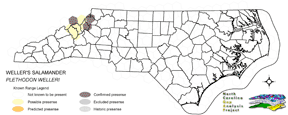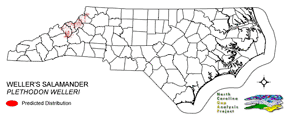
| Taxa: |
| Order: |
| Family: |
| Amphibia |
| Caudata |
| Plethodontidae |
| NatureServe Global Rank: |
| NatureServe State (NC) Rank: |
| G3 |
| S2 |
| Federal Status: |
| NC State Status: |
| --- |
| SC |


| Land Unit |
| US Fish & Wildlife Service |
| US Forest Service |
| US National Park Service |
| US Department of Defense |
| NC State Parks |
| NC University System |
| NC Wildlife Res. Com. |
| NC Forest Service |
| NC Div. of Coastal Mgmt. |
| Local Governments |
| Non-Governmental Org. |
| Other Public Lands |
| Private Lands |
| GAP Status 1-2 |
| All Protected Lands |
| Statewide |
| Hectares |
| 0.00 |
| 13,347.72 |
| 0.00 |
| 1,337.58 |
| 116.37 |
| 13.95 |
| 139.95 |
| 0.00 |
| 0.00 |
| 1,362.96 |
| 2,421.09 |
| 0.00 |
| 37,719.90 |
| 3,554.91 |
| 18,710.10 |
| 56,459.52 |
| Acres |
| 0.00 |
| 32,982.93 |
| 0.00 |
| 3,305.23 |
| 287.56 |
| 34.47 |
| 345.82 |
| 0.00 |
| 0.00 |
| 3,367.95 |
| 5,982.64 |
| 0.00 |
| 93,207.88 |
| 8,784.37 |
| 46,233.65 |
| 139,514.49 |
| % of Dist. on |
| Prot. Lands |
| 0.0 % |
| 71.3 % |
| 0.0 % |
| 7.1 % |
| 0.6 % |
| < 0.1 % |
| 0.7 % |
| 0.0 % |
| 0.0 % |
| 12.8 % |
| 12.8 % |
| 0.0 % |
| 0.0 % |
| 19.0 % |
| ----- |
| ----- |
| % of Dist. on |
| All Lands |
| 0.0 % |
| 23.6 % |
| 0.0 % |
| 2.4 % |
| 0.2 % |
| < 0.1 % |
| 0.2 % |
| 0.0 % |
| 0.0 % |
| 2.4 % |
| 4.3 % |
| 0.0 % |
| 66.8 % |
| 6.3 % |
| ----- |
| ----- |
|
The range of this species in North Carolina is restricted to the northern mountain counties bordering Virginia or the northeastern tip of Tennessee (Martof et al. 1980). It is found in most upper elevation forests, particularly spruce-fir (Martof et al. 1980) but also in mixed and deciduous forests of birch-spruce, birch-hemlock or northern hardwoods. Populations are usually found on forested mountain summits, mesic woodland talus slopes, and in cove hardwood forests (Redmond and Scott 1996). NATURE SERVE GLOBAL HABITAT COMMENTS: Spruce-fir, birch-hemlock, and primarily deciduous forests at 700-1800 m. Also grassy spots and boulder fields. Usually under rocks, logs, or leaf litter during day. Tends to be associated with rocky substrates. Seemingly most abundant in forests with much cover of rocks and downed logs (Mitchell 1991). Eggs are laid in small cavities in rotting conifer logs or beneath moss mats. NATURE SERVE STATE HABITAT COMMENTS: Primarily spruce forests and to a lesser degree, northern hardwood forests. |
| Code | Name | Description | NC Natural Heritage Program Equivalent |
| 521 | Spruce/Fir Forest | High Elevation Frazer-Fir - Red Spruce, Red Spruce and Red-Spruce-Yellow Birch Forests. Tree densities included here include both woodland to forest density. Highly intermixed with Northern Hardwoods, Grassy Balds, and Shrub Balds. | Red Spruce--Fraser Fir Forest, Fraser Fir Forest |
| 522 | Northern Hardwoods | High Elevation forests including yellow birch, American beech, and yellow buckeye. Includes forests with Hemlock and Yellow Birch. | Northern Hardwoods Forest, Boulderfield Forest |
| 523 | Grassy Bald | High Elevation grassy balds including Pennsylvania sedge, mountain oatgrass, as well as shrubby areas dominated by Alleghany and smooth blackberry. | Grassy Bald |
| 526 | Appalachian Cove Forest | Mixed Mesophytic forests of the mountains. Includes tuliptree, basswood, yellow buckeye and surgar maple. This class is mapped to include cove forests dominated or co-dominated by hemlock. | Rich Cove Forest, Acidic Cove Forest |
| 527 | Appalachian Hemlock | Upland hemlock forests of the moutains region. Vary from side slopes to steep slope positions. | Canada Hemlock Forest |
|
Redmond, W. H., and A. F. Scott. 1996. Atlas of amphibians in Tennessee. The Center for Field Biology, Austin Peay State University, Miscellaneous Publication Number 12. v + 94 pp.
Thurow, G. R. 1964. Plethodon welleri. Cat. Am. Amph. Rep. 12.1-12.2. Behler, J. L., and F. W. King. 1979. The Audubon Society field guide to North American reptiles and amphibians. Alfred A. Knopf, New York. 719 pp. Martof, B. S., W. M. Palmer, J. R. Bailey, and J. R. Harrison, III. 1980. Amphibians and reptiles of the Carolinas and Virginia. University of North Carolina Press, Chapel Hill, North Carolina. 264 pp. Mitchell, J. C. 1991. Amphibians and reptiles. Pages 411-76 in K. Terwilliger (coordinator). Virginia's Endangered Species:Proceedings of a Symposium. McDonald and Woodward Publishing Company, Blacksburg, Virginia. |
For more information please contact them at:
NC-GAP Analysis Project
Dept. of Zoology, NCSU
Campus Box 7617
Raleigh, NC 27695-7617
(919) 513-2853
www.basic.ncsu.edu/ncgap